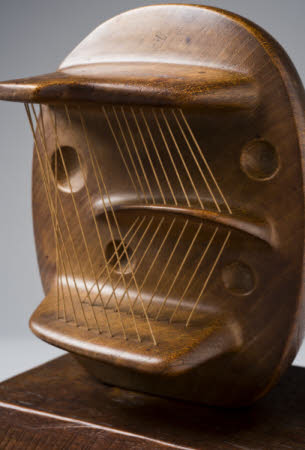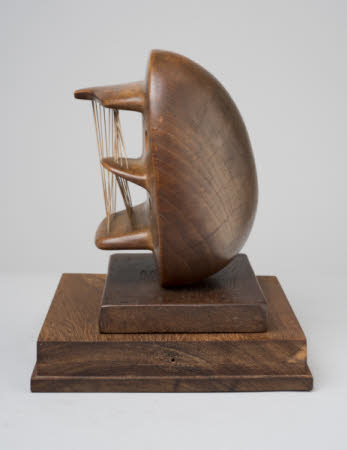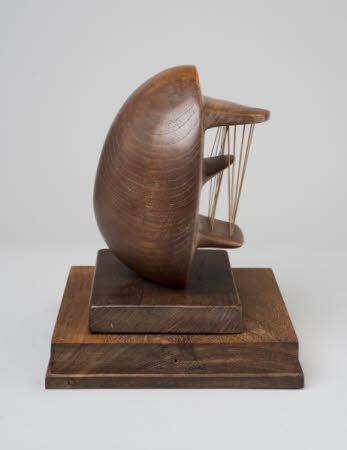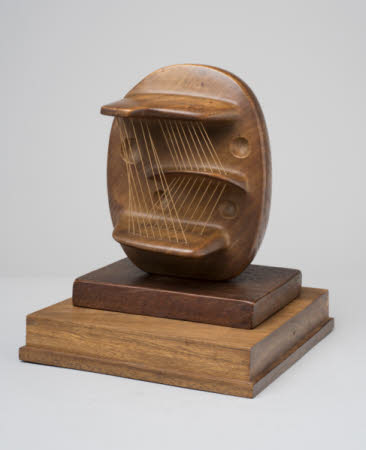Head
Henry Moore OM, CH, FBA (Castleford 1898 - Much Hadham 1986)
Category
Art / Sculpture
Date
1938
Materials
Elm, string
Measurements
220 x 160 x 170 mm
Place of origin
London
Order this imageCollection
2 Willow Road, London
NT 112757
Summary
Elmwood and string, ‘Head’, by Henry Moore OM, CH, FBA (Castleford 1898 - Much Hadham 1986), 1938. An anthropomorphically carved hemispherical solid piece of elm, designed to look like a stylised head, with four concave hemispherical indentations to the front and three protruding curved shelves, which are interconnected by lengths of string, rope strung diagonally. Mounted upon a square varnished wooden plinth. Its title in 1938 was ‘String Figure (No.2)’.
Full description
Henry Moore made his first stringed sculptures in 1937, inspired by models in the Science Museum illustrating mathematical propositions, which had first made an impression upon the artist when he was still a student at the Royal College of Art. Moore wrote in later years that ‘It wasn’t the scientific study of these models but the ability to look through the strings as with a bird cage and to see one form within another which excited me.’ He ‘did stringed figures only for two or three years, as I found, after a period, that the use of strings in sculpture was almost too ingenious, too easy.’ (Moore 1968, pp. 105-07). The sculpture ‘Head’ was one of three stringed sculptures Moore made in 1938 in elm wood, a material of which he was fond. Most of his subsequent stringed sculptures were however made for casting in metal. The sculpture may be seen in a drawing, Four Forms (Tate), also made in 1938. It is not clear whether the drawing represents the definitive model for Head or whether it was drawn from the completed sculpture. Head may be seen as a form of extension of the mask sculptures being made by Moore in the 1920s but, rather than the influences of ancient Mexican art seen in the earlier works, here Moore derives his concepts from surrealism, with resonances with contemporary works by artists such as Ben Nicolson and Naum Gabo. David Sylvester. whose writings were informed by many discussions with Henry Moore, wrote of the sculptor’s string sculptures: ‘The string, taut and weightless, presents a contrast with the curvilinearity and the density of the solid parts. It creates a transparent barrier between the space enclosed within the concaves of the sculpture and the space around the sculpture. Movement of the eye along the length of the strings sharpens awareness of the space the sculpture encloses, especially when one set of strings can be seen through another, so that a counterpoint of movement is created which quickens the vibration of the space.’ (Sylvester 1966, p. 105). It has been suggested that the sculpture Head possesses an unearthly, almost daemonic strangeness, the set of strings, passing at different levels and in different directions in front of the rather humanoid form serving to emphasise the depth of the sculpture, but also to introduce a series of strange and disconcerting relationships (Neumann 1959, p. 70). Jeremy Warren, 2018
Provenance
Acquired in 1942 from Henry Moore by Ernö Goldfinger from the Aid to Russia exhibition held at 2 Willow Road (no. 65, at 25 guineas). Owned by Ernö Goldfinger and Ursula Ruth Blackwell, also known as Mrs Ernö Goldfinger. Purchased by the National Trust in 1994 with support from other charitable foundations and private donors.
Credit line
National Trust Collections (2 Willow Road, The Ernő Goldfinger Collection)
Makers and roles
Henry Moore OM, CH, FBA (Castleford 1898 - Much Hadham 1986), sculptor
Exhibition history
Architects’ Houses (working title), Sir John Soane's Museum, London, 2023
References
Read 1938: Herbert Read (foreword), Realism and Surrealism (ex. cat.), Gloucester 1938; venue: Guildhall, London 1938, nos. 119-20 (‘one drawing and two carvings’) Exhibition of Modern Painting and Sculpture at 2 Willow Road Hampstead on behalf of the “Aid to Russia” Fund of the National Council of Labour (ex. cat.) London 1942; venue: 2 Willow Road, London 1942, no. 65 Read 1944: Herbert Read, Henry Moore. Sculpture and Drawings, Vol. 1, London 1944, Pl. 91a Johnson Sweeney 1946: J. Johnson Sweeney, Henry Moore (ex. cat.), New York 1946; venue: Museum of Modern Art, New York 1946, p. 51, no. 43 Read 1957: Herbert Read, Henry Moore. Sculpture and Drawings, Vol. 1, 4th edition, with catalogue, London 1957, pp. 12, 126, no. 188 Sylvester 1968: David Sylvester, Henry Moore (ex. cat.), London 1968; venue: Tate Gallery, London 1968, p. 105, cat. no. 41 Moore 1968: Henry Spencer Moore, John Hedgecoe (photography), Henry Moore, London 1968, p. 112, fig. 3 Melville 1970: Robert Melville, Henry Moore. Sculptures and Drawings 1921-1969, London 1970, Pl. 179 Henry Moore. Sculptures et desseins, (ex.cat.), Paris 1977; venue: Orangerie des Tuileries, Paris 1977, no. 30 Ades 1978: Dawn Ades, Dada and Surrealism Reviewed, (ex. cat.), London 1978; venue: Hayward Gallery, London 1978, p. 364, no. 14.34 Henry Moore the Carver. An Eightieth Birthday Tribute. Carvings from 1923-1975, (ex. cat.) London 1978; venue: Fischer Fine Art, London 1978, no. 14 Peter Moores Liverpool Project 6: Art into the 80s (ex. cat.), Liverpool 1981; venue: Walker Art Gallery, Liverpool 1981, no. 95 Lieberman 1983: William S. Lieberman, Henry Moore. 60 Years of his Art, (ex. cat.), New York 1983; venue: Metropolitan Museum of Art, New York 1983, pp. 47, 122. Moore and Levine 1983: Henry Moore and Gemma Levine, Henry Moore. Wood Sculpture, London 1983, pp. 104-05 Compton 1988: Susan Compton, Henry Moore, (ex. cat.) London 1988; venue: Royal Academy of Arts, London 1988, no. 33 Lichtenstern 2008: Christa Lichtenstern, Henry Moore. Work-Theory-Impact, London 2008, p. 133, fig. 159














